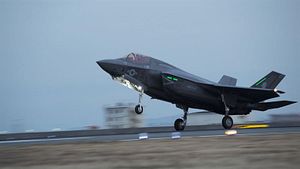The United States has dispatched its first F-35B squadron to Japan. According to the United States Marine Corps, the first F-35B aircraft of Marine Fighter Attack Squadron 121 arrived at an airbase in Iwakuni in Yamaguchi Prefecture on January 18.
This constitutes the F-35B’s first overseas mission.
The F35B is the U.S. Marine Corps variant of the supersonic fifth-generation F-35B Lightning II Joint Strike Fighter, capable of vertical or short takeoffs and vertical landings without requiring a catapult launcher. The F-35B was specifically developed to replace the Marine Corps’ F/A-18 Hornet, AV-8B Harrier and EA- 6B Prowler aircraft.
“The unique combination of stealth, cutting-edge radar and sensor technology, and electronic warfare systems bring all of the access and lethality capabilities of a fifth-generation fighter, a modern bomber, and an adverse-weather, all-threat environment air support platform,” the U.S. Marine Corps noted in a January 12 statement.
Ten F-35Bs departed Marine Corps Air Station Yuma in Arizona on January 9 for Japan. Six additional F-35Bs are slated to join in June, bringing up the squadron to full combat strength. The aircraft will replace F/A-18 Hornet and AV-8B Harrier II fighter jets currently based at Marine Corps Air Station Iwakuni.
“The F-35B brings strategic agility, operational flexibility, and tactical supremacy to the Pacific with a mission radius greater than that of the F/A-18 Hornet and AV-8B Harrier II in support of the U.S.- Japan alliance,” according to the U.S. Marine Corps.
“The F-35B represents the future of Marine Corps tactical aviation, and bringing it to Japan makes MCAS [Marine Corps Air Station] Iwakuni the second only operational F-35B base,” said U.S. Marine Corps Major Jimmy Braudt on January 18.“One of its capabilities is a powerful sensor suite that fuses together several different sources and provides superior situational awareness to the pilot.”
“It will be the first short takeoff and vertical landing aircraft permanently based in this theater, and it is capable of countering modern threat systems beyond what legacy aircraft were designed to handle.”
As I reported elsewhere, the U.S. Navy will deploy one of its largest surface warships, the Wasp-class amphibious assault ship USS Wasp, to Japan in the fall of 2017. The ship will be able to operate the F-35B from its flight deck. In November and December 2016, the U.S. Navy conducted a number of operational tests of the F-35B aboard an America-class amphibious assault ship in preparation for the deployment of the warship to the Asia-Pacific region (See: “F-35B Completes Weapons Load Testing on US Navy Amphibious Assault Ship”).
Tokyo will also soon operate its own fleet of F-35As. The first foreign military sales (FMS) F-35A fighter jet was handed over to Japan in late November. The Japan Air Self Defense Force (JASDF) will receive 42 F-35As in the coming years. Furthermore, the JASDF is set to procure up to 100 additional new fifth-generation air superiority fighter aircraft by the 2030s.

































